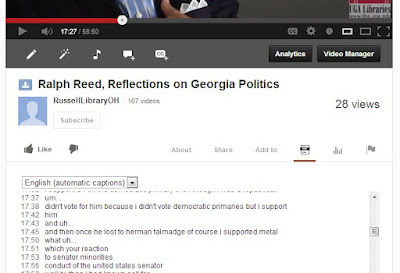My regular gig is cataloging monographs over at the UGA Main Library, but in early January I started interning here at the Russell Library to work on the Reflections on Georgia Politics Oral History Collection. It's an amazing collection of video interviews that gives researchers an in depth look at Georgia's modern political history from the people who served, or are still serving, the state.
ROGP has been through many steps since the project began in 2006. Now, I am facilitating the next phase in the process of making this collection accessible: creating finding aids for each interview.
In addition to getting some wonderful archival processing experience, I'm also getting a first class education in 20th century Georgia political history. These two aspects of the internship feed into one another, because the more familiar I become with the subject matter the better I get at creating finding aids. It's exciting to get this collection up and running because it has immense research value and the project really taps into the mission of the Russell Library. On top of that, I can now impress my friends as I confidently spout off facts about the Talmadge machine, the county unit system, the politics of school desegregation, and the rise of the Republican Party.
One of my favorite interviews I have written description for so far features Carl Sanders, Governor of Georgia from 1963 to 1967. He recalls the decision-making process surrounding the integration of UGA (Sanders was then president pro tem of the Georgia senate) and shares his views about race and politics. While UGA's integration has been written and talked about at length by a number of experts over the years, this represents one of those rare glimpses into a historic moment from someone who played a major role in the process. Check out the discussion around 19:20.
Stay tuned for more updates about Reflections on Georgia Politics!
Post by Steve Armour, Intern, Russell Library
ROGP has been through many steps since the project began in 2006. Now, I am facilitating the next phase in the process of making this collection accessible: creating finding aids for each interview.
In addition to getting some wonderful archival processing experience, I'm also getting a first class education in 20th century Georgia political history. These two aspects of the internship feed into one another, because the more familiar I become with the subject matter the better I get at creating finding aids. It's exciting to get this collection up and running because it has immense research value and the project really taps into the mission of the Russell Library. On top of that, I can now impress my friends as I confidently spout off facts about the Talmadge machine, the county unit system, the politics of school desegregation, and the rise of the Republican Party.
One of my favorite interviews I have written description for so far features Carl Sanders, Governor of Georgia from 1963 to 1967. He recalls the decision-making process surrounding the integration of UGA (Sanders was then president pro tem of the Georgia senate) and shares his views about race and politics. While UGA's integration has been written and talked about at length by a number of experts over the years, this represents one of those rare glimpses into a historic moment from someone who played a major role in the process. Check out the discussion around 19:20.
Stay tuned for more updates about Reflections on Georgia Politics!
Post by Steve Armour, Intern, Russell Library






